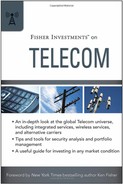Notes
Chapter 1: Telecom Basics
1. Global Financial Data, Inc. Monthly total return figures 1/31/1962–12/31/2009.
2. Ibid.
3. MSCI. The MSCI information may be used only for your internal use, may not be reproduced or redisseminated in any form and may not be used to create any financial instruments or products or any indices. The MSCI information is provided on an “as is” basis, and the user of this information assumes the entire risk of any use made of this information. MSCI, each of its affiliates, and each other person involved in or related to compiling, computing or creating any MSCI information (collectively, the “MSCI Parties”) expressly disclaims all warranties (including, without limitation, any warranties of originality, accuracy, completeness, timeliness, non-infringement, merchantability, and fitness for a particular purpose) with respect to this information. Without limiting any of the foregoing, in no event shall any MSCI Party have any liability for any direct, indirect, special, incidental, punitive, consequential (including, without limitation, lost profits) or any other damages.
4. See note 3.
5. OECD, “OECD Communications Outlook 2009: Executive Summary” (2009), www.oecd.org/dataoecd/24/32/43472431.pdf (accessed November 10, 2010), p. 13.
6. Ibid.
7. Copyright © 2010 The McGraw-Hill Companies, Inc. Standard & Poor’s including its subsidiary corporations (S&P) is a division of the McGraw-Hill Companies, Inc. Reproduction of this Work in any form is prohibited without S&P’s prior written permission.
8. Hank Intven, Telecommunications Regulation Handbook, The World Bank, November 2000, www.infodev.org/en/Publication.22.html, pp. 1–2, (accessed 11/09/2010).
Chapter 2: A Brief History of the Telecom Industry
1. Adjusted for inflation (CPI). Calculated using the US Bureau of Labor Statistics Inflation Calculator. http://data.bls.gov/cgi-bin/cpicalc.pl Note: Calculator only goes back to 1913. An annual inflation of 2.5% was assumed from 1880 to 1913.
2. Adam D. Thierer, “Unnatural Monopoly: Critical Moments in the Development of the Bell System Monopoly,” The Cato Journal (Fall 1994), www.cato.org/pubs/journal/cjv14n2-6.html (accessed 11/09/2010).
3. Leondard S. Hyman, Richard C. Toole, and Rosemary M. Avellis, The New Telecommunications Industry: Evolution and Organization (Public Utility Reports, May 1987).
4. Ibid.
5. Gerald W. Brock, The Telecommunications Industry: The Dynamics of Market Structure (Harvard University Press, June 1981).
6. See note 3.
7. See note 5.
8. See note 3.
9. Adjusted for inflation (CPI). Calculated using the US Bureau of Labor Statistics Inflation Calculator. http://data.bls.gov/cgi-bin/cpicalc.pl (accessed 11/09/2010).
10. Ibid.
11. See note 2.
12. Statistics of Communications Common Carriers, 2006/2007 Edition, US Federal Communications Commission, www.fcc.gov/Daily_Releases/Daily_Business/2010/db0916/DOC-301505A1.pdf (accessed 11/09/2010).
13. Ibid.
Chapter 3: Telecom Sector Composition
1. “6.1.2 Per Capita and Household Expenditure on Communications,” ICT Regulation Toolkit, www.ictregulationtoolkit.org/en/Section.3337.html (accessed 11/09/2010).
2. Thomson Reuters, MSCI ACWI Index, as of 12/31/09.
3. See Chapter 1, note 3.
4. See note 2.
5. Ibid.
6. See Chapter 1, note 3.
Chapter 4: Telecom Sector Drivers
1. See Chapter 1, note 3.
Chapter 5: Consumer Demand
1. Andre Levisse, Nimal Manuel, and Martin Sjolund, “Getting More From Prepaid Mobile Services,” McKinsey Quarterly (February 2008), www.mckinseyquarterly.com/Getting_more_from_prepaid_mobile_services_2108 (accessed November 10, 2010).
2. Ericsson, “Pre-paid Subscribers in Charge,” (March 19, 2010), www.ericsson.com/news/1395590 (accessed November 10, 2010).
3. IDC, “Worldwide Smartphone Market Grows 89.5% Year Over Year in Third Quarter as New Devices Launch, Says IDC” (November 4, 2010), www.idc.com/about/viewpressrelease.jsp?containerId=prUS22560610§ionId=null&elementId=null&pageType=SYNOPSIS (accessed November 10, 2010).
4. AT&T, “AT&T Leads the US in Smartphones and Integrated Devices” (May 15, 2009), www.att.com/gen/press-room?pid=4800&cdvn=news&newsarticleid=26819 (accessed November 10, 2010).
5. Organisation for Economic Co-operation and Development, “OECD Communications Outlook 2009: Executive Summary” (2009), www.oecd.org/dataoecd/24/32/43472431.pdf (accessed November 10, 2010), p. 15.
6. Ibid.
Chapter 6: Challenges and Opportunities
1. Verizon, “Fiber to the Premises (FTTP),” www22.verizon.com/about/community/tx/technology/technology.html (accessed November 11, 2010).
2. Amy Standen, “The Phone Book’s Days Appear Numbered” (January 18, 2010), NPR, www.npr.org/templates/story/story.php?storyId=122693536 (accessed November 11, 2010).
3. Ibid.
4. Ibid.
Chapter 7: The Top-Down Method
1. Matthew Kalman, “Einstein Letters Reveal a Turmoil Beyond Science,” Boston Globe (July 11, 2006), www.boston.com/news/world/middleeast/articles/2006/07/11/einstein_letters_reveal_a_turmoil_beyond_science/ (accessed December 10, 2009).
2. Michael Michalko, “Combinatory Play,” Creative Thinking, www.creativethinking.net/DT10_CombinatoryPlay.htm?Entry=Good (accessed December 10, 2009).
3. Gary P. Brinson, Brian D. Singer, and Gilbert L. Beebower, “Determinants of Portfolio Performance II: An Update,” Financial Analysts Journal 47 (1991), 3.
4. See Chapter 1, note 3.
5. Ibid.
6. Ibid.
7. Ibid.
8. Ibid.
9. Ibid.
